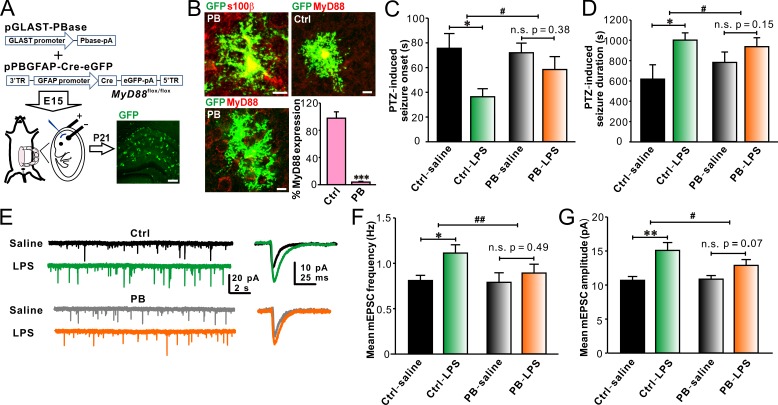Figure 6.
Astrocytic MyD88 deletion in vivo attenuates the effects of LPS on PTZ-induced seizure susceptibility and excitatory synaptic transmission in juvenile mice. (A) Schematics of experimental procedures of piggyBac (PB)–IUE in MyD88flox/flox mice (left) and representative image of hippocampal slices from PB-IUE mice (right). Bar, 200 µm. (B) Representative GFP-positive cells electroporated with the PB (left) and control (Ctrl; top right) plasmids in the hippocampus immunohistostained with s100β (top left) and MyD88 (bottom left and top right) and quantification of the percentage of MyD88 expression in GFP-positive astrocytes (bottom right). n = 7 for each group. Bars, 10 µm. Partially deleting astrocytic MyD88 abolished LPS-induced reduction in onset (C) and prolongation of duration (D) of PTZ-induced seizures in young mice. n = 6, 5, 6, and 7 for Ctrl-saline, Ctrl-LPS, PB-saline, and PB-LPS groups, respectively. (E) Representative traces of mEPSC recordings in CA1 pyramidal neurons from P14 IUE mice. Astrocytic MyD88 deletion prevented LPS-induced increases in mEPSC frequency (F) and amplitude (G) in CA1 pyramidal neurons from P14 IUE mice. n = 6, 7, 9, and 9 for Ctrl-saline, Ctrl-LPS, PB-saline, and PB-LPS groups, respectively. *, P < 0.05; **, P < 0.01; ***, P < 0.001; #, P < 0.05; ##, P < 0.01 (in B, t test; in C, D, F, and G, two-way ANOVA with the post hoc Holm-Sidak test). Data are mean ± SEM.

